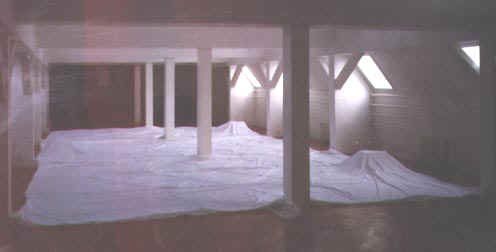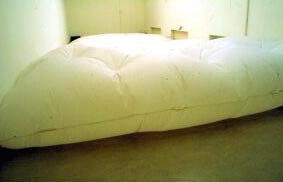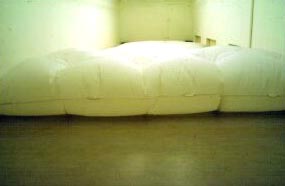![]()
|
|
Ilona Németh The
exhibition will be opening at 6PM |
“ The boundaries between art and non art are not the same as the boundaries between “aesthetic“ and “unaesthetic“. Something beautiful is continuously flowing into art and reflecting something beautiful outwards. This beauty can be as frightening as capturing, as dreadful as owerpowering, but that is exactly what all life is about, what we are and where we are..“
Jindøich Chalupecký
According to Carl Gustav Jung, one of the founders of modern psychology, the modern man of these days has found himself in a mental crisis, he has lost his ability of psychological experience and, at the same time, is losing his psychological balance. Jung characterised the soul /Psyche/ as conscious and unconscious (subconscious) mutually supplementing relations, based on the law of energy preservation (energy compensation).
Perhaps it was a kind of unconscious tidying up one´s own inside, a mental hygiene of one´s own psychospheres as the preparation for the exhibition “Paradigm Woman“ within the everyday, troublesome but also affectionate, stereotype household work; news coming from the radio, distressing calls of fright, about the war in Yugoslavia, the voices came as an echo... - and perhaps exactly this banal activity as washing the floor was an impulse, became a stigma. The Floor! The touch, which is possible exactly here, cannot be avoided. A symbol. Thanks to the gravitation of all substances to our Earth, all the people have to walk on it. But was IT really like that...? How much of cruel irony, pain and joy is then between the banal visuality and the inner cross-roads of the woman’s world...
In 1996 Ilona Németh, at her installation in gallery in Zilina, via an interaction between the visitor and the created surrounding, raised the problem of psychosomatic processes, communication without the possibility of escape; being directive, she did not offer us any other choice than either to go through or to leave! No more does she care for the view from “outside“, no direction of communication is set for us (Running the Gauntlet, 1994; The Way, 1996), we are not led into mysterious, uncertain and enclosed spaces, saturated by the odour of nature (Labyrinth, 1996; The Wall - The Wailing Wall,1995); she rejects (even an illusionary) separation of her works from the surrounding material space. The author works with the atmosphere - with the softly diffused light and scent. She makes the interior radically tight by - the artistically minimalist monumental abbreviation.She lays accurately, symmetrically 147 snow-white pillows on to the floor - hard, starched ones, smelling of chlorine (or lyzol of field hospitals?) People and things have to have an order! To be trampled on, soiled and dishonoured without delay...
The author wants us to live our own experience, a tangible, real broadening of our horizon by experience, that is unimaginable in advance. We are compelled to look at the philosophy of the processional work through the filter of our own evocation and experience.
The installation of Pillows - The Floor I is changing day by day! The murmur and creaking of steps is diminishing at the end, the fragile emotionality of our dreams on whitish bolsters, the feeling of the home’s warmth are gradually disappearing. Traces are left on the crumpled pillows, ambivalent tensions stemming from the encounter of values intimate, social, emotional and mentally-ethical. While power makes a man arrogant, the intimacy of poetry humanises him. What is left? ( Perhaps not only the illusion that the author’s role has changed for the role of a creator at least for a while).
At the Floor II - Let’s Sweep Under the Carpet, 1997 (created together with Ágnes Deli) Ilona Németh goes beyond this. The artists are complexly building an artistically formulated space. One of them has created a tracked “floor“, the other one a pliable soft “sky“ above it. The distance between them is of a natural human dimension. Moreover it could be said that they are creating a ritual-like environment. They induce a scene (composed of light, space, surface , form, motion, touch and sound) which helps to release the spontaneity of our inner life. The catharsis of polarities. They simulate situations when our senses serve only as a mean of perceiving a piece of work (touch-contact, hearing-sound), the body experiences its own story, its own self-reflexion - a reference about our own soul. The “Viewer“ is no longer a viewer, he becomes a participant, an organic part of the media space, he “learns to balance
in it“, perceives the surrounding from various focus points, while his experience is proportional to the size of his imagination. He crosses the “Labyrinth“ of his own conscious and unconscious perceptions. The object he is walking on is unknown, uncertain, covered with the fabric of a white sheet. How many empty furrows of perception! The floor is creaking, tumbling down. In the objects built-in microphones intensify the sound. (We notice, perhaps for the first time in Ilona Németh’s work a significant subduing (suppressing) of the visual quality of her work in order to intensify, to raise the emotional phenomenon and ethical idea, the sense and meaning of her work). And the sky... “Heaven“ is above you, you can touch it! You can both be afraid and play. You can search the secrets of your own soul or the pleasures of your body originating from discovery. You can walk through the “peaks and valleys“ of your own mind, you can grope, but jump as well ( the floor is concealing various found, preserved items and objects put aside - mattresses, toys, boxes, straw, carpets..) and you can “touch the stars“. The pure haptic and acoustic perception consciously awakes in the perceiver the “unknown“ or intensified awareness of the unity between the human soul and body, the understanding of our own body in harmony with mental gusts.
Both artists induce and mobilise a large scale of positive and negative reflexes, the individual fate in interpersonal relationships, rises and falls (between Heaven and Earth) and their relationships with the social and natural environment. The meaning previously expressed through the elements of nature, while establishing a metaphorical polarity of relationship between nature and society, the material and spiritual world, has been transferred by the author directly onto the man. Where do the boundaries between illusion and reality end?
It is only up to us and within us...
Practice indicates that “upbringing by experience“ or learning from the emotions of one’s soul and body, stemming from personal experience, penetrate our inside life much deeper than the exchange of opinions or thoughts.
In one of her confessions Ilona Németh stated that: “...an installation is like a sonnet. Although sonnets were created mainly in the Middle Ages, it does not mean they cannot be written nowadays, too“. Since her third work with floor, The Breathing Floor (1998) evokes this connection at the utmost, it is appropriate to quote an extract from a contemporary Slovak sonnet. (free translation) “Roared the whirl - and he created with ease a sonnet, a biting dialogue with a spirit. Entering the Beauty’s Court for a rhyme,/...polished, turned it in his head, melted it / by the precise hand of a bridge builder./
/ An organism with a wildly streaming fluid,/...
This is how substances of the space and earth are placed in his precious stone.“, wrote Daniel Hevier about this genre in a Shakespearean sonnet.
In fact the huge vitality and the way - in a sense of a consequent approach in addressing, expressing ideas, contents, relations and states - how Ilona Németh performs the realisation of a “saturated phenomenon“ is astonishing even shocking, however, as shown in the course of years, this becomes characteristic, moreover decisive for this fine artist. The “viewer“ - recipient is addressed by the human dimension of her installations.
The initial idea of “The Breathing Floor“ was to revive the astonishingly silent, monotonous, dull, false imitations of the warmth of a city, in fact she wanted to make the walls of the exhibiting area of the palace, soaked in cold and impersonality, breathe again. The irritating reality of the “emptied“ - lifeless surroundings of our galleries and museums without real communication with the environment, at present a special paradoxical reality in Slovakia, induced her the idea, to let to lifeless walls breathe through their “pores“, or to put in a counterpoint the live, primary element - the breath. The white, soft cloth dominating almost the entire floor of the grandiose exhibition space (stripped of useless props), as if veiled in a soft, diffused mist, forms the prologue to the monumentally outlined “breathing“. The moment of our entering the milieu evokes an astounding effect, the “revival“ of the work.
Three pieces of huge, at the same time fragile, vulnerable, snow-white “pillows“ start to inflate gradually - to inhale and exhale. The suggestive sound effect (sucking in and out) of ventilators is backed by meditative sound music, evoking interrupted and spontaneous breathing, attracts us to the entrails of the palace and like a materialised echo is winding from the very top down to the ground floor “A live object in a lifeless surrounding“ begins to communicate with our breath. (An accurate usage of interactive techniques intensifies the overall effect of the installation and helps us forget the mechanical “revival of the matter at hand“. We perceive a captivating and dreadful rapture through this expression.
The most precious thing we possess, is our BREATH. And in spite of this we quite naturally assume that exhalation is followed by further inhalation. The spontaneity of the organs of our body is unbelievable precisely defined by the spontaneity of our inner, sensible and mental procedures.
Do you know this condition? You can feel it like a “lump“, a “knot“ in your chest or throat, blocking your breathing..., then you overcome it slowly with pain, you carefully take a deep breath again and slowly exhale afterwards; while trying it again, overcoming uncertainty, fear, pain... you are coping with something deep inside you, that you only suspect many times,that you cannot even define or do not want to do so... Breathing is mapping the state of your soul.
Each cell of our body is the inheritance of the continuous chain of living nature. It is breathing.
However only the man is part of the complex nature, the creator of spiritual and social structures...
All Ilona Németh´s floors mentioned so far are white-clean-innocent at the beginning. It is a “Tabula rasa“ at the threshold of the birth of our knowledge. The breathing floor remained as it was till the end of the exhibition - reflecting in such a way the positive thinking of the author. The fragile feeling of balance, joy and satisfaction - happiness, resides in each of us when searching for the values of ourselves. The meditative dimension of the Floor IV was exactly such a zone of etherical emotionality, where you could, after having realised the coherences within yourself, start to search. It’s a pity that only the younger people had the courage to lie or sit down on the floor and breathe with it! Their faces and eyes were beaming with contentment and enlightenment, so precious a desire for harmony...Is it boldness to breathe freely and fully?!



